Independent Contractors
On This Page
Introduction
The following graphs and tables present data for the Coal and Noncoal (Metal, Nonmetal, Stone, and Sand & Gravel) Contractors. The information is organized by Employees, Fatalities, and Injuries. The Employees section details the number of employee hours by work location. The Fatalities section describes the number of occupational fatalities overall. The Injuries section presents the number of nonfatal lost-time injuries by work location and accident class. Data source: Mine Safety and Health Administration (MSHA). See Statistical Methodology for further details. Additional Mining Facts for each commodity are available from 2000 through 2015.
Employees
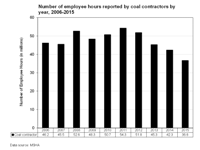 Number of Employee Hours Reported by Coal Contractors by Year, 2006-2015: Graph displaying the number of coal contractor employee hours reported from 2006 through 2015. The employee hours varied over the period from 46.2 in 2006, to a high of 54.3 million hours reported in 2011. From that point, the employee hours declined to low of 36.6 million in 2015.
Number of Employee Hours Reported by Coal Contractors by Year, 2006-2015: Graph displaying the number of coal contractor employee hours reported from 2006 through 2015. The employee hours varied over the period from 46.2 in 2006, to a high of 54.3 million hours reported in 2011. From that point, the employee hours declined to low of 36.6 million in 2015.
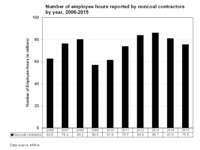 Number of Employee Hours Reported by Noncoal Contractors, 2006-2015: Graph displaying the number of noncoal contractor employee hours reported from 2006 through 2015. The employee hours increased from 62.6 million in 2006 to 80.2 million hours in 2008. After a decline to 56.9 million hours in 2009, the hours increased again to a high of 86.1 million employee hours in 2013. There were 75.5 million hours reported in 2015.
Number of Employee Hours Reported by Noncoal Contractors, 2006-2015: Graph displaying the number of noncoal contractor employee hours reported from 2006 through 2015. The employee hours increased from 62.6 million in 2006 to 80.2 million hours in 2008. After a decline to 56.9 million hours in 2009, the hours increased again to a high of 86.1 million employee hours in 2013. There were 75.5 million hours reported in 2015.
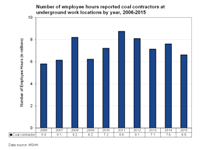 Number of Underground Employee Hours Reported by Coal Contractors, 2006-2015: Graph displaying the number of underground coal contractor employee hours reported from 2006 through 2015. The employee hours increased over the period from a low of 5.8 million hours in 2006 to a high of 8.8 million hours reported for 2011. In 2015 the employee hours reported was 6.6 million.
Number of Underground Employee Hours Reported by Coal Contractors, 2006-2015: Graph displaying the number of underground coal contractor employee hours reported from 2006 through 2015. The employee hours increased over the period from a low of 5.8 million hours in 2006 to a high of 8.8 million hours reported for 2011. In 2015 the employee hours reported was 6.6 million.
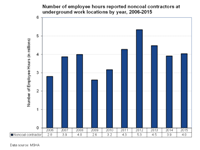 Number of Underground Employee Hours Reported by Noncoal Contractors, 2006-2015: Graph displaying the number of underground noncoal contractor employee hours reported from 2006 through 2015. The employee hours increased steadily from 2.8 million in 2006 to 4.0 million hours in 2008. After a decline to 2.6 million hours in 2009, the hours increased again to a high of 5.3 million employee hours in 2012. There was 4.0 million hours reported in 2015.
Number of Underground Employee Hours Reported by Noncoal Contractors, 2006-2015: Graph displaying the number of underground noncoal contractor employee hours reported from 2006 through 2015. The employee hours increased steadily from 2.8 million in 2006 to 4.0 million hours in 2008. After a decline to 2.6 million hours in 2009, the hours increased again to a high of 5.3 million employee hours in 2012. There was 4.0 million hours reported in 2015.
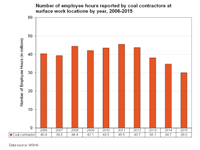 Number of Surface Employee Hours Reported by Coal Contractor, 2006-2015: Graph displaying the number of surface coal contractor employee hours reported from 2006 through 2015. The employee hours varied over the period from 40.4 million in 2006 to a high of 45.5 million hours reported for 2011. The hours declined from that point to a low of 30.0 million employee hours in 2015.
Number of Surface Employee Hours Reported by Coal Contractor, 2006-2015: Graph displaying the number of surface coal contractor employee hours reported from 2006 through 2015. The employee hours varied over the period from 40.4 million in 2006 to a high of 45.5 million hours reported for 2011. The hours declined from that point to a low of 30.0 million employee hours in 2015.
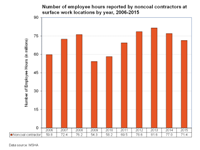 Number of Surface Employee Hours Reported by Noncoal Contractors, 2006-2015: Graph displaying the number of surface noncoal contractor employee hours reported from 2006 through 2015. The employee hours increased steadily from 59.8 million in 2006 to 76.2 million hours in 2008. After a decline to 54.3 million hours in 2009, the hours steadily increased to a high of 81.6 million employee hours in 2013. There were 71.4 million hours reported in 2015.
Number of Surface Employee Hours Reported by Noncoal Contractors, 2006-2015: Graph displaying the number of surface noncoal contractor employee hours reported from 2006 through 2015. The employee hours increased steadily from 59.8 million in 2006 to 76.2 million hours in 2008. After a decline to 54.3 million hours in 2009, the hours steadily increased to a high of 81.6 million employee hours in 2013. There were 71.4 million hours reported in 2015.
Fatalities
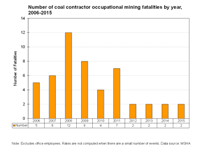 Coal Contractor Occupational Mining Fatalities by Year, 2006-2015: Graph displaying the number of occupational mining fatalities, excluding office employees, from 2006 through 2015. Rates are not computed when there are a small number of events. Fatalities varied over the period with the highest number being 12 in 2008. The years with the least number of fatalities were 2012, 2013, 2014 and 2015 with two fatalities occurring each year.
Coal Contractor Occupational Mining Fatalities by Year, 2006-2015: Graph displaying the number of occupational mining fatalities, excluding office employees, from 2006 through 2015. Rates are not computed when there are a small number of events. Fatalities varied over the period with the highest number being 12 in 2008. The years with the least number of fatalities were 2012, 2013, 2014 and 2015 with two fatalities occurring each year.
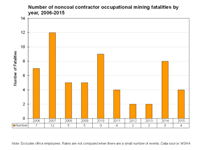 Noncoal Contractor Occupational Mining Fatalities by Year, 2006-2015: Graph displaying the number of occupational mining fatalities, excluding office employees, from 2006 through 2015. Rates are not computed when there are a small number of events. Fatalities varied over the period with the highest number being 12 in 2007. The years with the lowest number were 2012 and 2013 with two fatalities reported each year. In 2015, four fatalities were reported.
Noncoal Contractor Occupational Mining Fatalities by Year, 2006-2015: Graph displaying the number of occupational mining fatalities, excluding office employees, from 2006 through 2015. Rates are not computed when there are a small number of events. Fatalities varied over the period with the highest number being 12 in 2007. The years with the lowest number were 2012 and 2013 with two fatalities reported each year. In 2015, four fatalities were reported.
Injuries
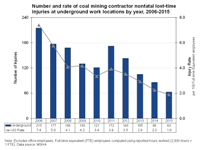 Number and Rate of Coal Mining Contractor Nonfatal Lost-time Injuries at Underground Work Locations by Year, 2006-2015: Graph displaying the number and rate of coal mining contractor nonfatal lost-time injuries at underground work locations, excluding office employees, from 2006 through 2015. Full-time equivalent (FTE) employees are based on 2,000 employee hours worked per year. The numbers varied over the period from a high of 215 in 2006 to a low of 63 in 2015. The rates have shown a downward trend from 7.4 nonfatal lost-time injuries per 100 FTEs in 2006 to a low of 1.9 per 100 FTEs in 2015.
Number and Rate of Coal Mining Contractor Nonfatal Lost-time Injuries at Underground Work Locations by Year, 2006-2015: Graph displaying the number and rate of coal mining contractor nonfatal lost-time injuries at underground work locations, excluding office employees, from 2006 through 2015. Full-time equivalent (FTE) employees are based on 2,000 employee hours worked per year. The numbers varied over the period from a high of 215 in 2006 to a low of 63 in 2015. The rates have shown a downward trend from 7.4 nonfatal lost-time injuries per 100 FTEs in 2006 to a low of 1.9 per 100 FTEs in 2015.
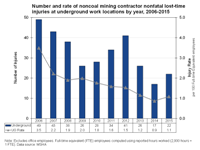 Number and Rate of Noncoal Mining Contractor Nonfatal Lost-time Injuries at Underground Work Locations by Year, 2006-2015: Graph displaying the number and rate of noncoal mining contractor nonfatal lost-time injuries at underground work locations, excluding office employees, from 2006 through 2015. Full-time equivalent (FTE) employees are based on 2,000 employee hours worked per year. The numbers have varied over the period from a high of 49 in 2006 to a low of 17 in 2014. There were 22 nonfatal lost-time injuries in 2015. The rates declined from 3.5 per 100 FTEs in 2006 to 1.1 per 100 FTEs in 2015.
Number and Rate of Noncoal Mining Contractor Nonfatal Lost-time Injuries at Underground Work Locations by Year, 2006-2015: Graph displaying the number and rate of noncoal mining contractor nonfatal lost-time injuries at underground work locations, excluding office employees, from 2006 through 2015. Full-time equivalent (FTE) employees are based on 2,000 employee hours worked per year. The numbers have varied over the period from a high of 49 in 2006 to a low of 17 in 2014. There were 22 nonfatal lost-time injuries in 2015. The rates declined from 3.5 per 100 FTEs in 2006 to 1.1 per 100 FTEs in 2015.
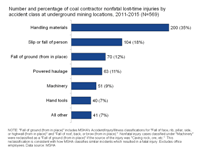 Number and Percentage of Coal Contractor Nonfatal Lost-time Injuries by Accident Class at Underground Mining Locations, 2011-2015: Graph displaying the distribution of nonfatal lost-time injuries by accident class for coal contractors at underground mining locations for the period from 2011 through 2015. There were a total of 569 lost-time injuries, excluding office employees. "Handling materials" had 35%, "Slip or fall of person“ had 18%, and "Fall of ground (from in place)," which includes MSHA's Accident/Injury/Illness Classifications for “Fall of face, rib, pillar, side, or highwall from in place” and “Fall of roof, back, or brow from in place,” had 12% of the nonfatal lost-time injuries. “Powered haulage” had 11% and “Machinery” had 9%. Note that nonfatal injury cases classified under machinery were reclassified as a fall of ground (from in place) if the source of the injury was caving rock, ore, etc. This reclassification is consistent with how MSHA classifies similar incidents which resulted in a fatal injury. "Hand tools" and the "All other“ category each had 7% of the nonfatal lost-time injuries during the 5-year period. Note that the sum of percentages may not equal 100 due to independent rounding.
Number and Percentage of Coal Contractor Nonfatal Lost-time Injuries by Accident Class at Underground Mining Locations, 2011-2015: Graph displaying the distribution of nonfatal lost-time injuries by accident class for coal contractors at underground mining locations for the period from 2011 through 2015. There were a total of 569 lost-time injuries, excluding office employees. "Handling materials" had 35%, "Slip or fall of person“ had 18%, and "Fall of ground (from in place)," which includes MSHA's Accident/Injury/Illness Classifications for “Fall of face, rib, pillar, side, or highwall from in place” and “Fall of roof, back, or brow from in place,” had 12% of the nonfatal lost-time injuries. “Powered haulage” had 11% and “Machinery” had 9%. Note that nonfatal injury cases classified under machinery were reclassified as a fall of ground (from in place) if the source of the injury was caving rock, ore, etc. This reclassification is consistent with how MSHA classifies similar incidents which resulted in a fatal injury. "Hand tools" and the "All other“ category each had 7% of the nonfatal lost-time injuries during the 5-year period. Note that the sum of percentages may not equal 100 due to independent rounding.
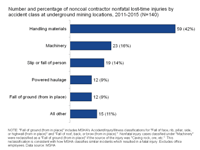 Number and Percentage of Noncoal Contractor Nonfatal Lost-time Injuries by Accident Class at Underground Mining Locations, 2011-2015:Graph displaying the distribution of nonfatal lost-time injuries by accident class for noncoal contractors at underground mining locations for the period from 2011 through 2015. There were a total of 140 lost-time injuries, excluding office employees. "Handling materials" had 42%, "Machinery" had 16% , "Slip or fall of person“ had 14%, and both "Powered haulage“ and “Fall of ground (from in place), which includes MSHA’s Accident/Injury/Illness Classifications for “Fall of face, rib, pillar, side, or highwall from in place” and “Fall of roof, back, or brow from in place,” had 9% of the nonfatal lost-time injuries during the 5-year period. Note that nonfatal injury cases classified under machinery were reclassified as a fall of ground (from in place) if the source of the injury was caving rock, ore, etc. This reclassification is consistent with how MSHA classifies similar incidents which resulted in a fatal injury. The "All other" category had for 11% of the nonfatal lost-time injuries. Note that the sum of percentages may not equal 100 due to independent rounding.
Number and Percentage of Noncoal Contractor Nonfatal Lost-time Injuries by Accident Class at Underground Mining Locations, 2011-2015:Graph displaying the distribution of nonfatal lost-time injuries by accident class for noncoal contractors at underground mining locations for the period from 2011 through 2015. There were a total of 140 lost-time injuries, excluding office employees. "Handling materials" had 42%, "Machinery" had 16% , "Slip or fall of person“ had 14%, and both "Powered haulage“ and “Fall of ground (from in place), which includes MSHA’s Accident/Injury/Illness Classifications for “Fall of face, rib, pillar, side, or highwall from in place” and “Fall of roof, back, or brow from in place,” had 9% of the nonfatal lost-time injuries during the 5-year period. Note that nonfatal injury cases classified under machinery were reclassified as a fall of ground (from in place) if the source of the injury was caving rock, ore, etc. This reclassification is consistent with how MSHA classifies similar incidents which resulted in a fatal injury. The "All other" category had for 11% of the nonfatal lost-time injuries. Note that the sum of percentages may not equal 100 due to independent rounding.
 Number and Rate of Coal Mining Contractor Nonfatal Lost-time Injuries at Surface Work Locations by Year, 2006-2015: Graph displaying the number and rate of coal mining contractor nonfatal lost-time injuries at surface work locations, excluding office employees, from 2006 through 2015. Full-time equivalent (FTE) employees are based on 2,000 employee hours worked per year. The numbers have varied over the period from a high of 342 in 2006 to a low of 109 in 2015. The rates have shown a downward trend over the period. The highest nonfatal lost-time injury rate was 1.8 per 100 FTEs in 2006 to a low rate of 0.8 per 100 FTEs in 2015.
Number and Rate of Coal Mining Contractor Nonfatal Lost-time Injuries at Surface Work Locations by Year, 2006-2015: Graph displaying the number and rate of coal mining contractor nonfatal lost-time injuries at surface work locations, excluding office employees, from 2006 through 2015. Full-time equivalent (FTE) employees are based on 2,000 employee hours worked per year. The numbers have varied over the period from a high of 342 in 2006 to a low of 109 in 2015. The rates have shown a downward trend over the period. The highest nonfatal lost-time injury rate was 1.8 per 100 FTEs in 2006 to a low rate of 0.8 per 100 FTEs in 2015.
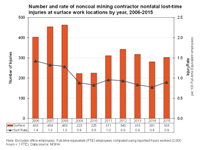 Number and Rate of Noncoal Mining Contractor Nonfatal Lost-time Injuries at Surface Work Locations by Year, 2006-2015: Graph displaying the number and rate of coal mining contractor nonfatal lost-time injuries at surface work locations, excluding office employees, from 2006 through 2015. Full-time equivalent (FTE) employees are based on 2,000 employee hours worked per year. The numbers have varied over the period from a high of 463 in 2008 to a low of 223 in 2009. The rates have shown a downward trend over the period, decreasing from 1.4 per 100 FTEs in 2006 to 0.8 per 100 FTEs in 2014. There were 303 nonfatal lost-time injuries in 2015 with a rate of 0.9 per 100 FTEs.
Number and Rate of Noncoal Mining Contractor Nonfatal Lost-time Injuries at Surface Work Locations by Year, 2006-2015: Graph displaying the number and rate of coal mining contractor nonfatal lost-time injuries at surface work locations, excluding office employees, from 2006 through 2015. Full-time equivalent (FTE) employees are based on 2,000 employee hours worked per year. The numbers have varied over the period from a high of 463 in 2008 to a low of 223 in 2009. The rates have shown a downward trend over the period, decreasing from 1.4 per 100 FTEs in 2006 to 0.8 per 100 FTEs in 2014. There were 303 nonfatal lost-time injuries in 2015 with a rate of 0.9 per 100 FTEs.
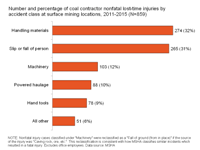 Number and Percentage of Coal Contractor Nonfatal Lost-time Injuries by Accident Class at Surface Mining Locations, 2011-2015: Graph displaying the distribution of nonfatal lost-time injuries for coal contractors by accident class at surface mining locations for the period from 2011 through 2015. There were a total 859 nonfatal lost-time injuries, excluding office employees. “Handling materials" had 32%, “Slip or fall of person" had 31%, and “Machinery” had 12% of the nonfatal lost-time injuries. Note that nonfatal injury cases classified under machinery were reclassified as a fall of ground (from in place) if the source of the injury was caving rock, ore, etc. This reclassification is consistent with how MSHA classifies similar incidents which resulted in a fatal injury. "Powered haulage" had 10%, "Hand tools" had 9%, and the "All other" category had 6% of the nonfatal lost-time injuries. Note that the sum of percentages may not equal 100 due to independent rounding.
Number and Percentage of Coal Contractor Nonfatal Lost-time Injuries by Accident Class at Surface Mining Locations, 2011-2015: Graph displaying the distribution of nonfatal lost-time injuries for coal contractors by accident class at surface mining locations for the period from 2011 through 2015. There were a total 859 nonfatal lost-time injuries, excluding office employees. “Handling materials" had 32%, “Slip or fall of person" had 31%, and “Machinery” had 12% of the nonfatal lost-time injuries. Note that nonfatal injury cases classified under machinery were reclassified as a fall of ground (from in place) if the source of the injury was caving rock, ore, etc. This reclassification is consistent with how MSHA classifies similar incidents which resulted in a fatal injury. "Powered haulage" had 10%, "Hand tools" had 9%, and the "All other" category had 6% of the nonfatal lost-time injuries. Note that the sum of percentages may not equal 100 due to independent rounding.
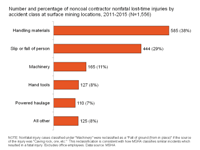 Number of Percentage of Noncoal Contractor Nonfatal Lost-time Injuries by Accident Class at Surface Mining Locations, 2011-2015: Graph displaying the distribution of nonfatal lost-time injuries by accident class for noncoal contractors at surface mining locations for the period from 2011 through 2015. There were a total of 1,556 lost-time injuries, excluding office employees. "Handling materials" had 38%, "Slip or fall of person" had 29% and “Machinery” had 11% of the nonfatal lost-time injuries. Note that nonfatal injury cases classified under machinery were reclassified as a fall of ground (from in place) if the source of the injury was caving rock, ore, etc. This reclassification is consistent with how MSHA classifies similar incidents which resulted in a fatal injury. "Hand tools" had 8%, "Powered haulage" had 7%, and the "All other" category had 8% of the nonfatal lost-time injuries during the 5-year period.
Number of Percentage of Noncoal Contractor Nonfatal Lost-time Injuries by Accident Class at Surface Mining Locations, 2011-2015: Graph displaying the distribution of nonfatal lost-time injuries by accident class for noncoal contractors at surface mining locations for the period from 2011 through 2015. There were a total of 1,556 lost-time injuries, excluding office employees. "Handling materials" had 38%, "Slip or fall of person" had 29% and “Machinery” had 11% of the nonfatal lost-time injuries. Note that nonfatal injury cases classified under machinery were reclassified as a fall of ground (from in place) if the source of the injury was caving rock, ore, etc. This reclassification is consistent with how MSHA classifies similar incidents which resulted in a fatal injury. "Hand tools" had 8%, "Powered haulage" had 7%, and the "All other" category had 8% of the nonfatal lost-time injuries during the 5-year period.
See Also
- Data & Statistics
- Independent Contractor Trends in the United States Mining Industry
- Injuries, Illnesses, and Hazardous Exposures in the Mining Industry, 1986-1995: A Surveillance Report
- Mining Fact Sheets
- Mining Facts - 2015
- Mining Facts for 2000
- Noncoal Contractor Mining Facts - 2003
- Nonmetal Operator Mining Facts - 2002
- Overall Mining Facts 2008 (HTML)
- Rib Falls: A Major Ground Control Issue
- Statistical Methodology
- Statistics: All Mining
- Stone Operator Mining Facts - 2005
- Page last reviewed: 4/12/2017
- Page last updated: 4/12/2017
- Content source: National Institute for Occupational Safety and Health, Mining Program


 ShareCompartir
ShareCompartir